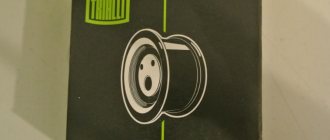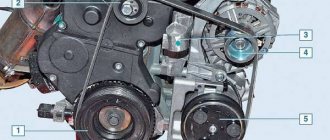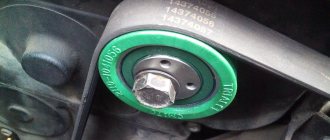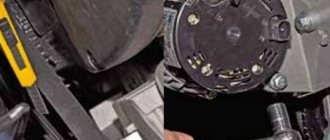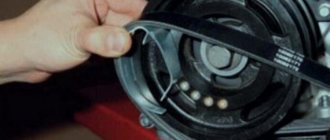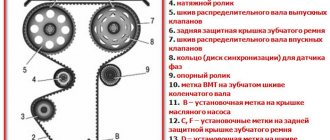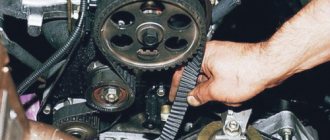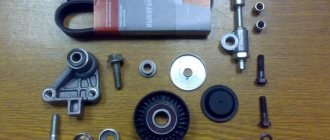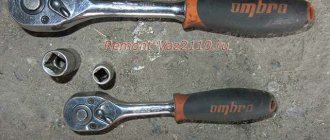Generator drive device
The main condition for the correct functioning of the generator is the correct transmission of rotation from the power plant. To generate the required amount of electricity, the element must rotate at high speed.
The alternator drive belt must be tensioned for proper transmission. If the belt sag, it will begin to slip on the pulleys. If the belt is overtightened, there is a risk of premature wear of the bearings, working surfaces of the pulley and belt.
To avoid these troubles, belt tension adjustment was included in the design.
In modern cars the number of attachments is large. This equipment is also driven by the crankshaft pulley, including the power steering pump and air conditioning compressor.
The drive of these two units and the generator is carried out using a single belt. Because of this, it is impossible to adjust the tension of the drive element using a generator. Such cars have a complex belt position configuration. Belt-driven equipment is located at different levels.
How to change the alternator belt tensioner pulley? To do this, you need to understand its structure. The generator belt tensioner roller is a bearing with a plastic lining on its outer race. The pad has a working surface along which the belt moves. There is a landing sleeve inside the roller. There are two types of rollers:
- Eccentric . The design of this video is quite simple. It contains only a bearing, a plastic lining and a bushing. A through hole passes through the bushing, offset away from the center of the roller. The roller is put on a pin through the hole, which is installed on the engine. To tighten, the roller must be rotated relative to the bolt.
- Roller with bracket . In this design, the roller is fixedly mounted on a bracket. The structure is attached to the power plant using bolts. Moving the bracket relative to the engine adjusts the tension. Manufacturers sometimes use rollers with a spring bracket. The spring allows you to independently adjust the tension.
The bearing is the main weak point of the roller. This part is forced to constantly experience loads. Wear of a part sometimes even ends in its complete breakdown.
It is recommended to change the bearing every time the belt is replaced.
Possible faults
Let's consider possible tensioner malfunctions and ways to eliminate them.
Roller wear. During its life cycle, a roller bearing makes a huge number of revolutions. Constantly moving and being under tension, he quickly breaks down. To check the condition of the bearing, you need to remove the alternator belt. A faulty bearing rotates unevenly and makes noise during operation.
Defects on the roller surface. For various brands of cars, rollers are made of plastic, steel or nylon. Their surface can be smooth or ribbed. The surface of the roller should be free of cracks, nicks and signs of wear. If such defects exist, the belt will cut into the surface of the roller and quickly wear out. To solve the problem, you need to replace the tensioner pulley.
Cracks and traces of rust. If rust drips from the tensioner, or there are streaks of rust between the arm and the base, the tensioner is damaged or its components are worn out. Most often, rust concentrates in the area of the mounting bolts and tensioner travel stops.
Worn tensioner lever. To diagnose the lever, you need to turn the tensioner full stroke, applying force to the lever with a wrench. The lever should move freely, without effort. If the lever squeaks and sticks, it needs to be replaced.
Spring weakening. If the components driven by the belt do not rotate, and the belt itself squeals as it slips, the tensioner spring is weak. For diagnostic purposes, move the tensioner lever full stroke using a wrench. If you do not have to apply any effort when moving the lever, or these efforts are minimal, it means that the spring has weakened. In this case, the tensioner should be replaced.
Tensioner block misalignment. If the mounting bracket is bent, the tensioner is not installed correctly, or there is corrosion between the base of the tensioner and the mounting surface, the belt will not sit flat on the pulley. Such misalignment can be detected using a laser level. If the misalignment cannot be corrected, the tensioner will have to be replaced.
Bracket wear. The bracket is another part that can cause the tensioner to fail. Over time, the bracket can bend and cause the roller to move out of the plane in which the belt lies. As a result, one side of the belt will stretch more than the other and the belt will wear out prematurely. If the belt is bent too much, it may come off.
If during diagnostics a bending of the bracket was detected, then you should not try to align it for two reasons. Firstly, after some time the bracket may become deformed again. Secondly, after straightening the bracket, there is no guarantee that the roller will be positioned correctly. Therefore, if wear is detected on the bracket, this part should be replaced.
ATTENTION! Bracket bending can be found even in new cars that have just come off the assembly line. Such a curvature indicates that the car has a manufacturing defect.
Signs of a faulty alternator belt tension roller
First, make sure that the alternator belt tensioner pulley needs to be replaced. Signs of its malfunction are listed below:
- the generator does not fully charge the on-board network or it does not receive electricity at all;
- from the side where the belt is located, a sound similar to squeaking is heard;
- a hum is heard;
- the roller or belt vibrates a lot when the power plant is running;
- there is play in the video;
- The belt is worn on one side.
Some of these symptoms may indicate a problem with the components that drive the roller. A hum and squeaking noise may indicate wear on the bearings of the power steering pump, air conditioner or compressor. The malfunction may lie in the generator itself.
Functions of timing rollers
Rollers are one of the most important components of the timing system. Their main function is to tension the belt during operation. Tensioners also serve as a belt stabilizer during operation.
Car owners should also take into account that the timing system uses two types of belt tensioners:
- bypass roller;
- tension roller.
Depending on the type of tensioners used, their function may vary slightly.
So, the function of the deflection roller is as follows:
- creating the required belt rotation angle for the correct operation of all auxiliary systems;
- reduction of noise from belt operation;
- elimination of belt vibrations during engine operation at high speeds.
A conventional belt tensioner has slightly different functions and is as follows:
- creating the necessary belt tension at which the entire power plant of the car will operate correctly;
- depending on the design of the motor, it can partially perform the functions of a deflection roller.
The above information will allow an inexperienced motorist to understand the function of the rollers, so that during their replacement they do not disrupt the operation of the entire engine as a whole.
Diagnostics of the drive belt tensioner
The drive belt tensioner must be checked for serviceability when at least one of the above symptoms appears. Other structural elements also need diagnostics. Diagnostics is performed in several stages:
- It is necessary to visually familiarize yourself with the belt and the equipment driven by it. To do this, start the power plant and check whether there are vibrations of the belt, pulley or roller.
- Check the tension of the alternator belt. To do this, stop the engine. Next, on the largest span between the pulleys, take the belt and try to turn it clockwise. If you can turn it 90 degrees, then its tension is fine. Otherwise, the rotation angle will be smaller or larger, and then adjustment will be required.
- The next step is to remove the belt and check its condition. It is also necessary to check the pulleys and rollers for play. Removing the belt is quite simple. To do this, you must loosen the tension pulley nut. After this, it must be removed from the pulleys. Before doing this, remember the position of the belt between the pulleys, because you will then have to put it back on. It is recommended to take a photo of the position with a mobile phone camera. After removal, check that there are no cracks or peeling on the belt. Belt wear should be even. If any of these defects are detected, feel free to change the belt. Note wear on one side. When such wear occurs, the roller mounting stud or bracket becomes bent, causing misalignment. If this misalignment is not corrected, the belt will not last long.
- The play on the pulleys is checked. Rotate the roller and make sure that there are no jams or jams. If they are present, there will be severe wear of the bearing, and the generator belt tension roller will need to be replaced. Also carefully inspect the working surface of the plastic pad: there should be no grooves on it. If the surface is uneven, the drive belt tension roller must be replaced.
- If after replacing the belt the hum and squeaking does not disappear, then the problem must be looked for in other elements. The drive of these elements occurs due to belt tension.
Snapshot
The surface of the toothed part of the belt should not have folds, cracks, undercuts of teeth and separation of fabric from rubber. The reverse side of the belt should not have wear, exposing the cord threads, or signs of burning. There should be no delamination or fraying on the end surfaces of the belt. If defects are found on the belt or there is a significant discrepancy between the belt tension control elements (see photo above), the belt must be replaced. You should also replace the belt with a new one if traces of engine oil are found on it (before installing a new belt, the cause of oil getting on the belt must be eliminated) or when replacing the coolant pump.
Attention! Failure of the timing belt (breakage and cutting of teeth) can lead to valves sticking into the pistons due to mismatch of the rotation angles of the crankshaft and camshaft and, as a result, to expensive engine repairs.
We replace the timing belt in accordance with the maintenance regulations every 75 thousand km or if defects are detected on the belt.
To avoid damaging the crankshaft position sensor, it must be removed.
Many drivers often do not have time to delve into the design features and subtleties of repairing a particular vehicle component. And if the purpose and maintenance of the main elements (for example, the engine, radiator, bridge, battery and others) is not difficult, then problems may arise with smaller parts. So, in practice, few people know what a timing belt tensioner pulley is needed for, what its malfunction can lead to, and how to change it. The information in this article will fill your knowledge gaps.
Purpose
The tension roller is one of the main elements of the gas distribution mechanism. The quality of tension of the timing belt, which connects the engine crankshaft and the car generator, depends on its serviceability. As a result, the stability of the on-board network voltage and normal battery charge are ensured.
How it works? When the engine is turned off, the generator is immobilized, so the battery takes on the entire load. After starting the engine, the crankshaft (via the timing belt) transmits rotation to the generator rotor. From this moment on, the on-board network switches to a new power source.
How to change the alternator belt tensioner pulley?
As an example, consider the Chevrolet Lacetti. This car is quite popular in Russia. It can be found on many trading platforms. In addition, this car has a typical design compared to other cars. The Chevrolet Lacetti is equipped with a self-adjusting tension roller with a bracket.
To replace the roller, you will need the following set of tools: a set of open-end wrenches and sockets with gates. The installation sequence is presented below:
- The air filter housing is removed from the engine. This is done to provide access to the belt.
- The power steering pump is unscrewed. After this you can get to the video itself. To get to its mounting bolts, it is necessary to remove the exhaust manifold protective screen from the engine.
- After the screen has been removed, the power steering pump bolts are unscrewed. The pump moves to the side to provide access to the roller. After unscrewing, you can remove the belt from its pulley. The pipes going to the pump do not need to be removed.
- Before unscrewing the roller, it must be brought into the mounting position. To do this, the roller moves, overcoming the force of the spring before the locking holes on the bracket body are aligned. Next, the roller is locked in the same position using a bolt or splitter installed in the hole.
- The bolts securing the bracket and roller are unscrewed. The roller is removed. The new element also needs to be moved into its installation position. After this, it is installed in the structure and secured with bolts.
- The power steering pump together with the protective screen are secured and installed in place. The belt is put on the pulleys. To do this, use a photo with the correct position of the belt.
- The locking bolt or cotter pin is removed. This is done so that the spring produces the necessary belt tension.
On other models, replacing the alternator belt tensioner pulley may be slightly different. Most often, on cars with eccentric rollers, tensioning is carried out using a special key. With this wrench, the roller is rotated around the pin for tension purposes.
Part numbers
Belt
Originals
In the catalog of original spare parts it is designated by the following numbers:
- K4M - 117206746R;
- H4M - 117204148R, 117203168R (kit with installation bracket);
- F4R - 117207944R;
- K9K - 8200821813.
Analogs
Attention! Analogs of the alternator belt can be sold as a set along with a tension pulley. Check before purchasing.
For K4M
| Manufacturer | vendor code | average price |
| RENAULT | 117206746R | 6798 |
| MILES | AD03001 | 3993 |
| GATES | K016PK1823XS | 4745 |
| LYNX | PK5006 | 3594 |
| RUEI | RUZ34087 | 3261 |
| DAYCO | KPV207 | 8926 |
| SKF | VKMA36201 | 8756 |
For H4M
| Manufacturer | vendor code | average price |
| AVANTECH | 7PK1051 | 586 |
| DAYCO | 7PK1055S | 735 |
| GALLANT | GLTB137 | 1191 |
| RENAULT | 117203168R | 6082 |
| RENAULT | 117203866R | 4096 |
| VAZ | 117203168R | 6841 |
For F4R
| Manufacturer | vendor code | average price |
| DAYCO | 7PK1790 | 1138 |
| EURO REPAR | 1609323080 | 1134 |
| FRANCECAR | FCR211030 | 1152 |
| GALLANT | GLTB136 | 740 |
| GATES | 7PK1793 | 1640 |
| GLOBELT | 7PK1792 | 762 |
| JD | 7PK1795 | 837 |
| LYNX | 7PK1793 | 998 |
| MEYLE | 500071795 | 1104 |
| MILES | 7PK1795 | 798 |
| PATRON | 7PK1795 | 928 |
| RENAULT | 117207944R | 1337 |
| SKF | VKMV7PK1792 | 1148 |
| SNR | KA85517 | 5865 |
| UKORAUTO | UCR207944R | 562 |
For K9K
| Manufacturer | vendor code | average price |
| ASAM SA | 30693 | 504 |
| AUTOMOTOR FRANCE | ABW1199 | 150 |
| AVANTECH | 6PK1200 | 593 |
| BANDO | 6PK1200 | 740 |
| BOSCH | 1987947577 | 600 |
| DAYCO | 6PK1200 | 583 |
| DAYCO | 6PK1205 | 674 |
| DAYCO | 13A1100C | 391 |
| DONGIL | 6PK1200 | 517 |
| FEBI | 28933 | 871 |
| FRANCECAR | FCR210202 | 613 |
| GALLANT | GLTB122 | 323 |
| GATES | 68381 | 250 |
| GLOBELT | 6PK1200 | 439 |
| GLOBELT | 6PK1205 | 404 |
| HUTCHINSON | 1200K6 | 739 |
| JD | 6PK1200 | 468 |
| JD | 6PK1205 | 523 |
| KLAXCAR FRANCE | 6PK1200 | 762 |
| LYNX | 6PK1203 | 542 |
| MILES | 6PK1200 | 499 |
| MILES | AD15154 | 434 |
| MILES | AD15020 | 505 |
| NEKO | 6PK1200 | 554 |
| PATRON | 6PK1200 | 535 |
| PATRON | 6PK1205 | 549 |
| PATRON | 6DPK1200 | 931 |
| QUATTRO FRENI | QF00100005 | 851 |
| RENAULT | 8200821813 | 1494 |
| SKF | VKMV6PK1199 | 589 |
Tension roller
Originals
In the catalog of original spare parts, tension rollers are identified by the following numbers:
- K4M - 8200933753, 117502781R;
- F4R - 117507271R;
- K9K - 8660001576.
The N4M engine installed on the Renault Duster is not equipped with a tension pulley, although the threaded mount is in the standard place.
Analogs
For K4M
| Manufacturer | vendor code | average price |
| CAFFARO | 500172 | 857 |
| DAYCO | APV3097 | 2840 |
| DENCKERMANN | P232001 | 1309 |
| FRANCECAR | FCR220016 | 2340 |
| GALLANT | GLTN13 | 626 |
| GALLANT | GLTN112 | 1295 |
| GATES | T39163 | 2636 |
| JD | JHT0119 | 1050 |
| LUK | 534047410 | 5094 |
| LYNX | PT3270 | 2108 |
| METALCAUCHO | 5162 | 2371 |
| MILES | AG00295 | 1618 |
| MILES | AG03183 | 610 |
| PATRON | PT36201T | 1508 |
| PATRON | PT36201 | 1026 |
| PILENGA | PTP4756 | 462 |
| RENAULT | 8200933753 | 3603 |
| RENAULT | 117502781R | 4134 |
| SKF | VKM36201 | 4819 |
| ZEKKERT | SR1216 | 655 |
| ZEKKERT | SR1187 | 1480 |
For F4R
| Manufacturer | vendor code | average price |
| RENAULT | 117507271R | 4776 |
| INA | 534014230 | 2861 |
| MILES | AG03109 | 642 |
| PATRON | PT36030B | 803 |
| NTY | RNKRE004 | 693 |
| CAFFARO | 30200 | 627 |
| SKF | VKM36030 | 2601 |
| SNR | GA35506 | 1371 |
| GATES | T38482 | 2569 |
| SNR | GA35500 | 2842 |
| DENCKERMANN | P222005 | 750 |
| LYNX | PB5222 | 1315 |
| LYNX | PT3139 | 2117 |
| HQ | HQ8200104754 | 270 |
| METALCAUCHO | 5261 | 589 |
| NIPPARTS | J1145039 | 1267 |
| GALLANT | GLTN113 | 1298 |
| GALLANT | GLTN117 | 665 |
| JP GROUP | 1218302000 | 747 |
| ZEKKERT | SR1358 | 676 |
| FEBI | 22329 | 3229 |
| RUVILLE | 55585 | 2850 |
| ZZVF | ZVRN104 | 687 |
| SWAG | 60922329 | 3385 |
| METALCAUCHO | 5262 | 2672 |
| AUTLOG | RT1200 | 3110 |
| DEPPUL | DERN104 | 630 |
For K9K
| Manufacturer | vendor code | average price |
| RENAULT | 8660001576 | 6043 |
| MILES | AG00039 | 1297 |
| METALCAUCHO | 5157 | 2228 |
| RIDEX | 312D0063 | 3245 |
conclusions
The generator belt tension roller is an important part, without which the correct functioning of the generator is impossible. At the slightest sign of severe wear, it is necessary to replace the generator belt tension roller. The roller can be found at a parts store. It is also necessary to monitor the remaining elements of the generator design. Replacing the tension roller of the alternator belt should not cause difficulties and can easily be carried out by the car owner himself without contacting a service station. Good luck and easy travels!
Source: auto-gl.ru
We will add only one thing on our own - do not neglect the advice of this article, and seek the service of replacing a spare part or repairing a car only at certified service stations or official dealers, because a malfunction of this part of the car can cause quite a lot of trouble on the road, and consequences afterwards, i.e. To. It's not just the alternator that turns the belt.
Consequences of driving with a loose timing belt
As mentioned above, the drive must be tightly tensioned, according to factory regulations. Otherwise, at any moment its teeth may jump to one or more positions, which will have a negative impact on the operation of the power unit.
Slip is possible on the gears, crankshaft pulley, and camshaft sprocket. In this case, the ignition necessarily shifts towards late and requires correction.
The amount of change in ignition parameters depends on the number of teeth. For example, if there are 100 of them, then the displacement of one tooth will cause a transformation of 3.6°. Naturally, the engine will work in such conditions, but how:
- fuel consumption will increase;
- starting up in the morning will become more difficult;
- traction will drop;
- the amount of exhaust smoke will increase.
And if several teeth jump, this will lead to a critical condition. An ignition offset of 5 angular degrees on vehicles equipped with an electronic control unit will cause the engine to stall. The computer protects the system from major damage - for example, a broken timing belt and valves meeting pistons. And if there is no control unit or it does not work correctly, damage is sure to occur with all the ensuing consequences.
Preparation for work
To change the timing belt tension roller yourself, you need to prepare a basic set of tools:
- spanners;
- knob;
- union heads;
- socket wrenches or screwdrivers;
- drills or wrench.
Under the protective cover covering the timing belt assembly there is a cover that needs to be removed. A roller and a gas distribution mechanism are hidden under it (however, the timing belt itself is installed inside the power unit, so you won’t be able to see it immediately after removing the protective cover). The tension mechanism is indicated by a red arrow, and the blue arrow indicates the nut that secures the roller.
If you unscrew it, you can completely remove the part from the motor. In addition, you will need to release the belt from the camshaft pulley. Otherwise, removing the roller will become impossible or the work will become inconvenient and difficult.
There is a bearing inside the roller (it can be seen from the outside), which ensures rotation of the product around its own axis after the engine starts. During operation, the part becomes unusable and begins to play. Try shaking the roller by hand, and if it makes squeaking or play, you will need to replace it immediately. Often the structure jams or begins to leak lubricant. This leads to increased engine noise.

